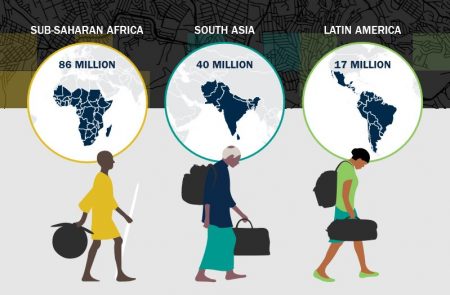March 22, 2018 – In a report called Groundswell, the World Bank projects that 55% of the Developing World’s population is at risk with over 143 million forced to migrate by 2050 because of climate change. That’s 32 years from now, within a generation. That should have all of humanity alarmed.
The report focuses on three regions: Sub-Saharan Africa (from Sudan and West Africa to the Cape of Good Hope), Central and South America (from Mexico to the Straits of Magellan), and South Asia (Afghanistan, Pakistan, India, Nepal, Bhutan, and Bangladesh).
In its findings, it concludes that up to 86 million in Sub-Saharan Africa, 40 million in South Asia, and 17 million in Central and South America, among the poorest people in the poorest countries, will be victimized leading to significant “in and out” migration because of crop failures, freshwater scarcity, and sea level rise. In-migration refers to people migrating within a country to search for a place of refuge. Out-migration has people crossing borders and even leaving continents to find refuge from the consequences of climate change.
The countries most impacted are ones with insufficient capital to make the harden infrastructure and provide social support systems for climate change victims. According to the report, the year 2050 is considered a tipping point beyond which climate change migration is expected to accelerate in the absence of significant cuts to greenhouse gas emissions plus money spent on mitigation and adaptation.
I know that 32 years still seems a long way away and that climate change is slow-moving enough for intervention well before the mid-century date. But as we are learning, although average mean temperatures may creep up slowly, extremes in weather are part of the phenomenon. Frequency and intensity of weather events including severe thunderstorms, monsoonal rains, more intense hurricanes and typhoons, droughts leading to crop failures, and drought-fed forest and grassland fires are all consequences of the climate changing. Add to that changes in the range of insect pests to further damage crops and spread disease and we no longer have an insidious problem but rather an overt one.
The consequences of climate change migration will be most felt by urban centres. Cities are the likely destination of climate refugees. That will put pressure on housing, transportation, utilities, social services, and employment. For in-migration, that means governments need to revise their planning and budgets to reflect where money needs to be allocated. For out-migration, it means addressing far more issues than the former. It means policies related to managing the influx and care of non-citizens under the constraints of limited funds.
And then, what about the people who stay in place despite changing climate conditions. For those living on coastlines, unless governments build desalination plants, freshwater may cease to exist as aquifers succumb to saltwater intrusion. And where sea level rise inundates coastal communities, governments may have to forcefully remove citizens who want to stay in place.
It would appear that governments at all levels need to prepare now for what is to come.
There are a number of actions that can be taken now including:
- Concerted efforts to cut greenhouse gases to limit the rise in temperature to below 2 Celsius (3.6 Fahrenheit).
- Educating the population to understand climate change and the specific risks to areas where they live and work.
- Making climate migration a part of the planning process.
- Creating options and choices for populations most at-risk to migration.
- Long-term budgeting for climate migration.
- Building new cities, homes, and infrastructure in relatively climate-stable regions.









